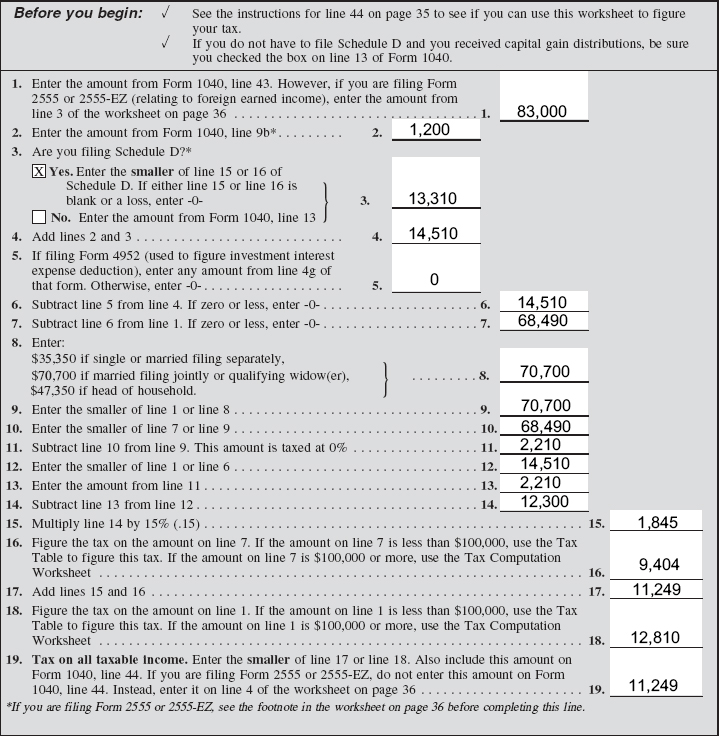5.8 Sample Entries of Capital Asset Sales on Form 8949 and on Schedule D
You report 2012 sales and other dispositions of capital assets on Form 8949. This includes sales of securities, redemptions of mutual-fund shares, worthless personal loans, sales of stock rights and warrants, sales of land held for investment, and sales of personal residences where part of the gain does not qualify for the home sale exclusion (29.1). After entering your short-term transactions in Part I of Form 8949 and long-term transactions in Part II, the total sales price and basis amounts are transferred to Schedule D where net gain or loss is figured.
Although capital gain distributions from mutual funds and REITs are generally reported as long-term capital gains on Line 13 of Schedule D, investors who receive such distributions but have no other capital gains or losses to report may generally report the distributions directly on Form 1040 or 1040A without having to file Schedule D; see 32.8 for details.
For 2012, the favorable maximum capital gain rates (5.3) apply to net capital gain (net long-term capital gain in excess of net short-term capital loss) from Schedule D, and also to qualified dividends (4.1). Although qualified dividends are subject to the same favorable maximum rates as net capital gain, they are not entered as long-term gains in Part II of Schedule D. The favorable rates are applied to qualified dividends when tax liability is computed on either the Qualified Dividends and Capital Gain Tax Worksheet or the Schedule D Tax Worksheet. The Schedule D Tax Worksheet in the Schedule D instructions is used only if you have a net 28% rate gain or unrecaptured Section 1250 gain (5.3). If you do not have a net 28% rate gain or unrecaptured Section 1250 gain, use the Qualified Dividends and Capital Gain Tax Worksheet in the Form 1040 instructions. The applicable Worksheet must be used to obtain the benefit of the favorable maximum capital gain rates for your net capital gain and qualified dividends.
Reporting transactions on Form 8949 and Schedule D.
Use Form 8949 to report your 2012 sales of capital assets. Part I of Form 8949 is for short-term gains and losses (assets held one year or less) and Part II is for long-term gains and losses (assets held more than one year). You may have to file more than one Form 8949 depending on how the sale was reported on Form 1099-B. In Parts I and II of Form 8949, you must check a box to indicate whether your basis for sold securities was reported to you by your broker in Box 3 of Form 1099-B: check box A if Form 1099-B shows basis; check box B if Form 1099-B does not show basis, and check box C if you did not receive Form 1099-B for the sale. A separate form must be used for each code, so if you had some box A transactions and some box B (or C) transactions, you must complete a separate Form 8949 for each type
In the columns of Form 8949, you report transaction details. You report your sales price in column (e) and your basis in column (f). Report adjustments to gain or loss in column (g). Broker’s fees, commissions, transfer taxes and other sale expenses should not be added to your basis in column (f) of Form 8949. If the broker included the expenses in reporting the net sales price on Form 1099-B, you enter that net sales price in column (e) of Form 8949. If the gross sales price was reported by the broker on Form 1099-B, you enter the gross sales price in column (e) and enter your sales expenses as a negative adjustment in column (g) of Form 8949, with code “O” entered in column (b). You can enter other negative adjustments in column (g) of Form 8949, such as the exclusion for gain on the sale of your principal residence (29.1), or the exclusion for gain on the sale of qualified small business stock (5.7); you enter the excluded amount as a negative amount in column (g) and enter the designated code in column (b); see the Form 8949/Schedule D instructions for details.
Form 8949 must be attached to Schedule D. The totals from columns (e), (f), and (g) of Form 8949 are transferred to the appropriate lines of Schedule D (depending on whether box A, B, or C is checked on Form 8949).
The Example below for John and Karen Taylor and accompanying worksheets illustrate how transactions are entered on Form 8949 and Schedule D.
Sample Form 8949—Sales and Other Dispositions of Capital Assets
(This sample is subject to change; see the e-Supplement at jklasser.com )
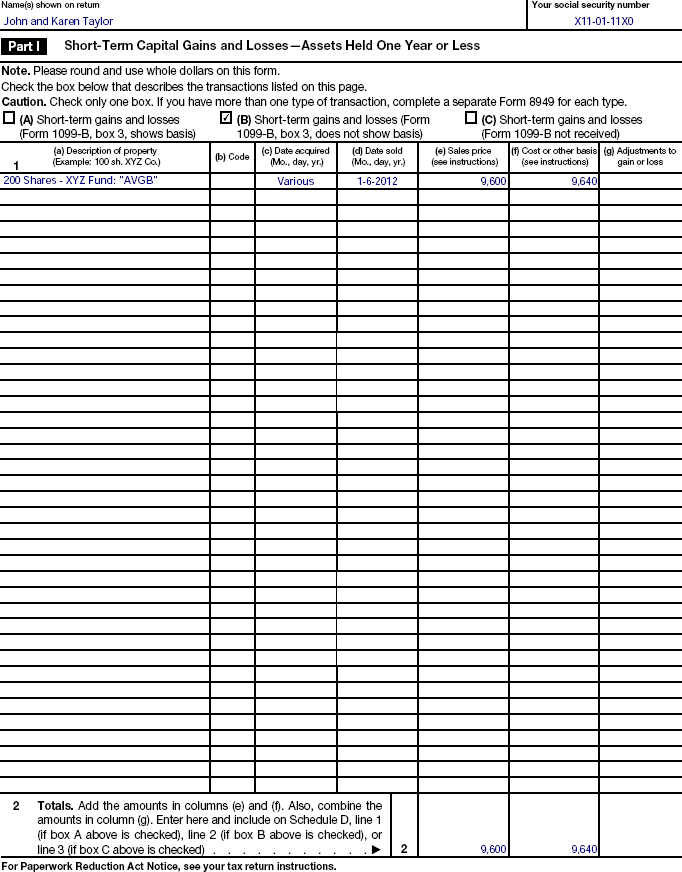
Sample Form 8949—Sales and Other Dispositions of Capital Assets
(This sample is subject to change; see the e-Supplement at jklasser.com )
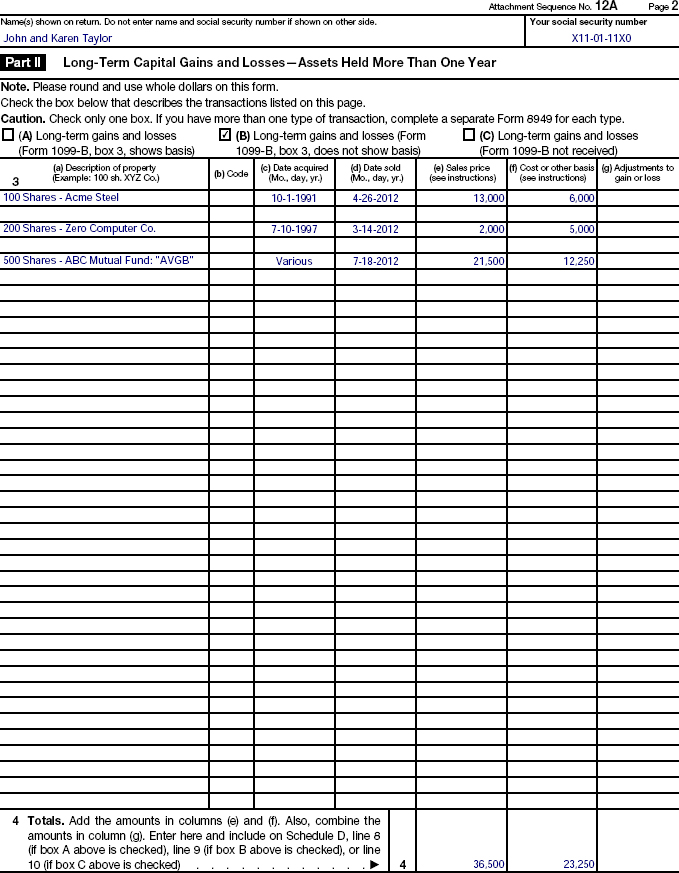
Sample Schedule D—Capital Gains and Losses
(This sample is subject to change; see the e-Supplement at jklasser.com )
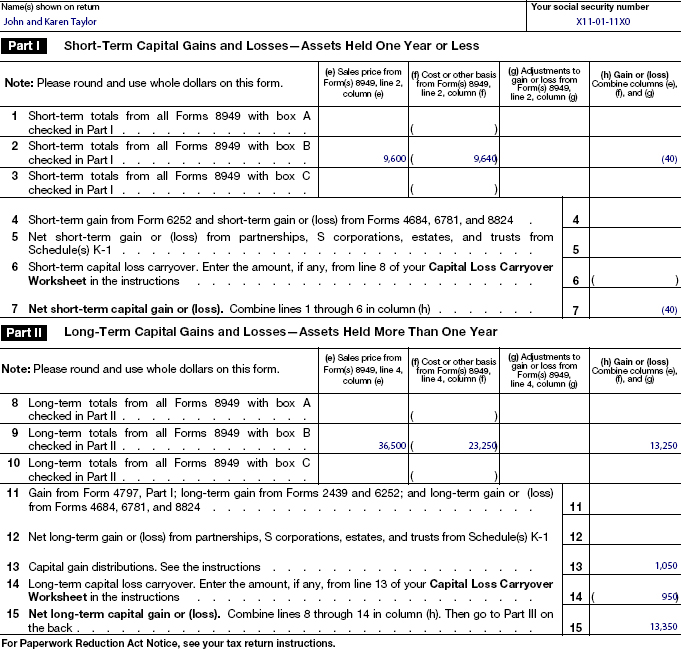
Sample Schedule D—Capital Gains and Losses
(This sample is subject to change; see the e-Supplement at jklasser.com )
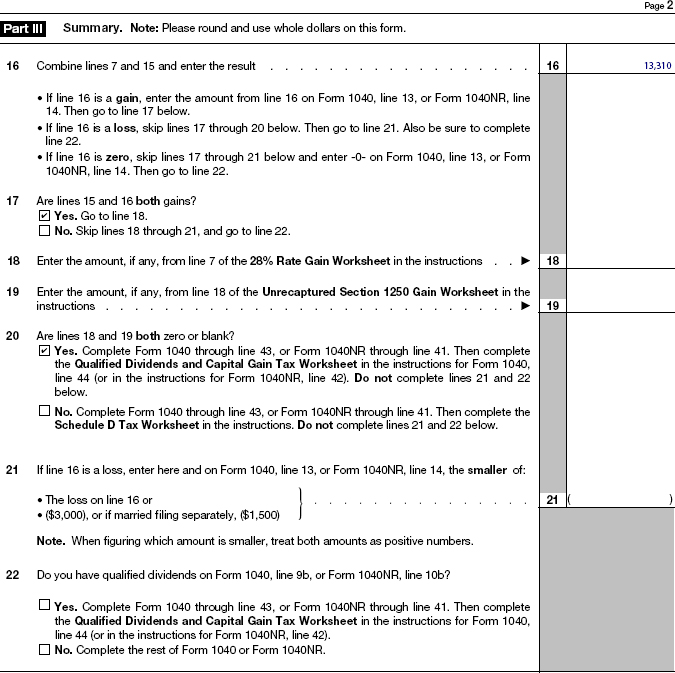
Sample worksheet for John and Karen Taylor (see the Example on page 107)
Sample Qualified Dividends and Capital Gains Worksheet
(This sample is subject to change; see the e-Supplement at jklasser.com )
